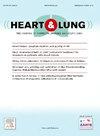哮喘-慢性阻塞性肺疾病重叠与神经肌肉连接处退化的程度高于单独的任何一种疾病
IF 2.6
4区 医学
Q2 CARDIAC & CARDIOVASCULAR SYSTEMS
引用次数: 0
摘要
患有哮喘、慢性阻塞性肺疾病(COPD)和哮喘-COPD重叠(ACO)的患者表现出与年龄相关的骨骼肌和身体机能下降的晚期形式,称为肌肉减少症。然而,神经肌肉接头(NMJ)降解对这些患者肌肉减少症的相对贡献仍然部分难以捉摸。方法招募老年男性,包括对照组(n=68)、哮喘患者(n=61)、COPD患者(n=74)和ACO患者(n=53),测量握力(HGS)、骨骼肌质量指数(SMI)、步态速度(GS)和短时间体能测试(SPPB)。我们还在研究人群中测量了血浆c端agrin-片段-22 (CAF22, NMJ降解的标志)和神经丝轻链(NfL,神经变性的标志)。结果哮喘、COPD和ACO患者HGS、SMI、GS和SPPB评分低于对照组,CAF22水平高于对照组(p < 0.05)。在个体疾病中,ACO与HGS和SPPB评分最低、CAF22水平最高相关(p < 0.05)。我们还观察到,在哮喘、COPD和ACO患者中,CAF22与HGS、GS和SPPB有显著相关性(均p < 0.05)。最后,CAF22对三种疾病的肌少症诊断均有显著疗效,ACO患者报告的AUC最高(均p < 0.05)。总之,我们报告了与单独患有这两种疾病的患者相比,ACO患者的NMJ降解生物标志物升高导致了更高程度的肌肉减少症和身体损害。我们的研究结果表明,NMJ是恢复慢性气道疾病患者肌肉健康和功能能力的治疗靶点。本文章由计算机程序翻译,如有差异,请以英文原文为准。
Asthma-chronic obstructive pulmonary disease overlap is associated with a higher degree of neuromuscular junction degradation than either disease alone
Background
Patients with asthma, chronic obstructive pulmonary disease (COPD), and asthma-COPD overlap (ACO) exhibit an advanced form of age-related decline of skeletal muscle and physical performance, termed sarcopenia. However, the relative contribution of neuromuscular junction (NMJ) degradation to sarcopenia in these patients remains partly elusive.
Methods
We recruited older men, including controls (n=68) and patients with asthma (n=61), COPD (n=74), and ACO (n=53), to measure handgrip strength (HGS), skeletal muscle mass index (SMI), gait speed (GS), and a short physical performance battery (SPPB). We also measured plasma C-terminal agrin-fragment-22 (CAF22; a marker of NMJ degradation) and neurofilament light-chain (NfL; a marker of neurodegeneration) in the study population.
Results
Patients with asthma, COPD, and ACO had lower HGS, SMI, GS, and SPPB scores and higher CAF22 levels than controls (all p<0.05). Among individual diseases, ACO was associated with the lowest HGS and SPPB scores and highest CAF22 levels (all p<0.05). We also observed significant correlations of CAF22 with HGS, GS, and SPPB in patients with asthma, COPD, and ACO (all p<0.05). Lastly, CAF22 exhibited significant efficacy in diagnosing sarcopenia in all three diseases, with the highest AUC reported in ACO patients (all p<0.05).
Conclusion
Altogether, we report a higher degree of sarcopenia and physical compromise with elevation of NMJ degradation biomarkers in patients with ACO than those with either disease alone. Our findings suggest NMJ as a therapeutic target to restore muscle health and functional capacity in patients with chronic airway diseases.
求助全文
通过发布文献求助,成功后即可免费获取论文全文。
去求助
来源期刊

Heart & Lung
医学-呼吸系统
CiteScore
4.60
自引率
3.60%
发文量
184
审稿时长
35 days
期刊介绍:
Heart & Lung: The Journal of Cardiopulmonary and Acute Care, the official publication of The American Association of Heart Failure Nurses, presents original, peer-reviewed articles on techniques, advances, investigations, and observations related to the care of patients with acute and critical illness and patients with chronic cardiac or pulmonary disorders.
The Journal''s acute care articles focus on the care of hospitalized patients, including those in the critical and acute care settings. Because most patients who are hospitalized in acute and critical care settings have chronic conditions, we are also interested in the chronically critically ill, the care of patients with chronic cardiopulmonary disorders, their rehabilitation, and disease prevention. The Journal''s heart failure articles focus on all aspects of the care of patients with this condition. Manuscripts that are relevant to populations across the human lifespan are welcome.
 求助内容:
求助内容: 应助结果提醒方式:
应助结果提醒方式:


